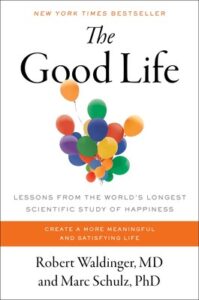by Julie Mackaman

“What keeps us healthy and happy as we go through life? If you were going to invest now in your future best self, where would you put your time and your energy?”
A rapt young audience listens to the questions posed by Dr. Robert Waldinger, MD, in the opening of his popular 2015 TED Talk, “What Makes a Good Life? Lessons from the World’s Longest Study of Happiness.” Dr. Waldinger has come prepared with an answer. He is only the fourth director in the 85-year history of the Harvard Study of Adult Development, a longitudinal project begun during the Great Depression that has followed two groups of men (a first-generation set now diversified by the inclusion of the second generation) into their 80s and 90s, up to their deaths. The ongoing study combines science and personal stories collected from its subjects at regular intervals in an effort to identify predictors of well-being and healthy aging.
So, what’s the single best investment we can make in our future self, whatever our age? Dr. Waldinger brought the study’s answer to both his TED Talk and to The Good Life, the book he co-wrote with the study’s assistant director, Dr. Marc Schulz, PhD, to convey what the in-progress project has revealed so far. Dr. Waldinger continues his TED Talk:

Dr. Robert Waldinger
“There was a recent survey of millennials asking them what their most important life goals were and over 80% said that a major life goal for them was to get rich. And another 50% of those same young adults said that another life goal was to become famous.”
Nope, the study shows that while those success-oriented goals may give us pleasure when we’re young, they’re not the most important investments we can make in ourselves for good health and longevity as we go through the sequential stages of life, whether as described by Shakespeare in As You Like It or psychologist Erik Erickson’s theory of psychosocial development. No, it’s something else.
Across 10 chapters, beginning with “What Makes a Good Life?” and ending with the conclusion, “It’s Never Too Late to Be Happy,” The Good Life introduces the study’s subjects at inflection points along their arc from youth toward old age. We see the research process in action, as physical and mental health measurements are taken. But we find answers in their responses to written questions and stories recorded by the interviewers across nearly their entire lifetimes. We get to know such subjects as Henry Keane, a young inner-city Boston teenager when he joined the study, his wife, Rosa, and their daughter, Peggy; John Marsden and Leo DeMarco, Harvard students whose goals and life paths diverged; and Wes Travers, whose father walked out on the family when Wes was seven years old. Through their candor, we learn the lessons of how the good life can emerge, through a combination of things we can or can’t control, decisions carried out or abandoned, and life’s journey through the unexpected.
So, what did Dr. Waldinger tell the young adults in his TED Talk audience that the Harvard study offers? It’s the central premise of The Good Life and appears right on the book cover’s inside flap:
“Good relationships keep us healthier and happier.”
Pick up the book and let the study’s directors make their case that relationships are what make for a good life, with tips on how to initiate, build, and maintain the relationships that can start helping you to flourish right now — and carry you across the finish line.
(Extra credit! Make the study’s findings personal and put Dr. Waldinger’s tips to work by taking the New York Times Well Desk: 7-Day Happiness Challenge.)
Return to TOC
